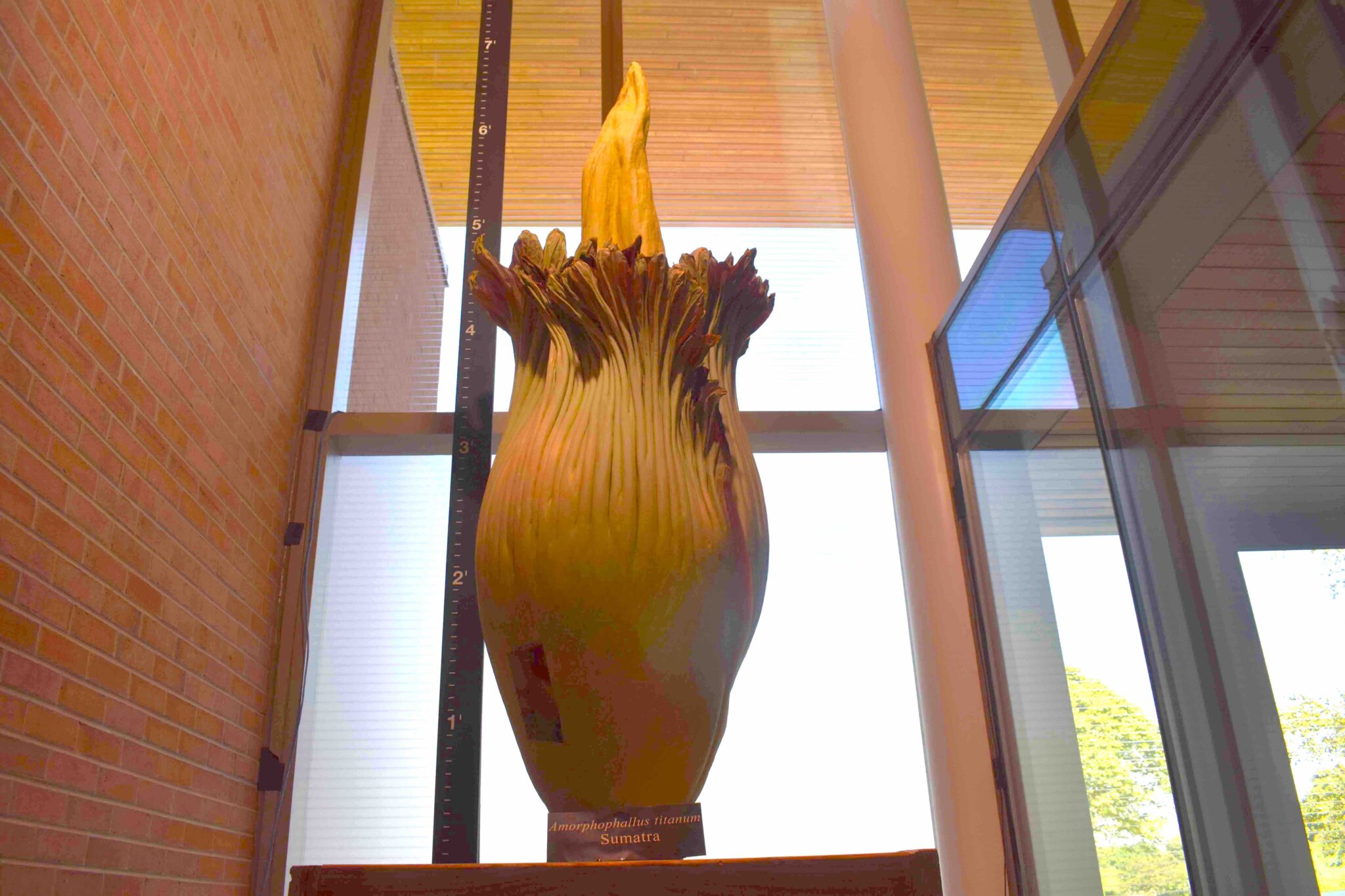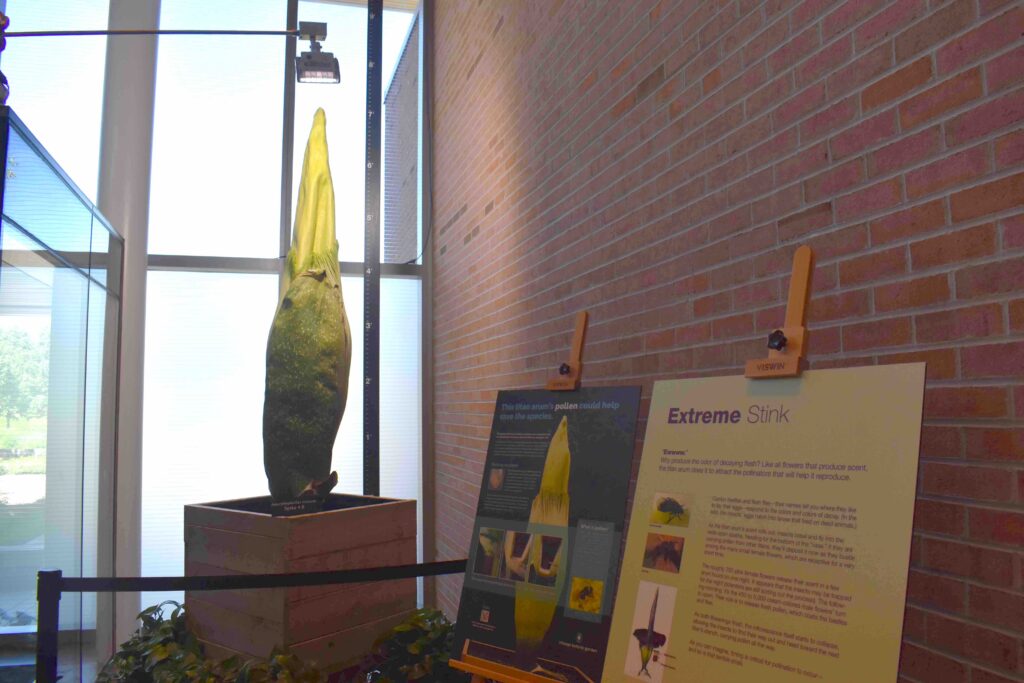
Take a whiff, but you better hurry. Botanic garden’s corpse flower stench won’t last long
The springtime smell of blossoming flowers carries into summer nights, but the guests at the Chicago Botanic Garden are getting a whiff of a different kind of fresh.
Rather than the refreshing smell of most flowers, the Titan arum releases an aroma similar to a dumpster on a hot day, and not one but two Titan arums — or corpse flowers — are blooming at the Chicago Botanic Garden in Glencoe.
The first Titan arum, named Sumatra, bloomed on June 7. The next, Spike 4.0, began to open on Saturday, June 15.

While thousands of flowers bloom yearly at the Chicago Botanic Garden, the Titan arums are special. Their bloom brings crowds from across the Midwest, not because of the flowers’ deep red color or grandiose peak, but rather the putrid odor they release — hence their nickname, the corpse flower.
Beyond their breathtaking odor, the Titan arum’s unpredictable nature also adds to the excitement and uniqueness of the bloom. Johanna Hutchins is an orchid floriculturist for the garden. Her work involves maintaining the amorphophallus family. Hutchins said last week she expected Spike to bloom soon, and the Chicago Botanic Garden social media team announced June 15 that the flower was in bloom.
“If you are looking for that really smelly experience, as soon as it starts to open and as soon as the garden is open, I would recommend coming in at that point because that’s when it is going to be prime time for the smell,” Hutchinson said.
The garden has a live stream of Sumatra and Spike.
Sumatra and Spike are currently on display in The Daniel F. and Ada L. Rice Plant Conservation Science Center, home to the Negaunee Institute for Plant Conservation Science and Action.
Several guests came to check out the Titan arums on display between Sumatra’s and Spike’s blooms. With Sumatra no longer in bloom and Spike just beginning to show signs of blooming, the visitors were treated to a much less smelly environment.
Wayne and Marian Bibergall drove over from Niles. Wayne Bibergall has become somewhat of a corpse flower chaser, as he accidentally stumbled upon one blooming in a garden in England.
“The one in England was pretty wild,” Wayne said. “Everyone started going ‘ooh and aah’ and then ‘oh my god.’”
The Bittick family visited the garden from Glenview. Having just finished school for the year, Mickey, Sam, and Annabel Bittick all were hoping for a whiff.
“They smell like my dog,” said Sam, who learned about all the different chemicals within the plant that make up that yucky smell. “They can smell like very stinky cheese, garlic, smelly feet and rotting fish.”
“It’s really surprising how they are just so tall,” Mickey said, adding that he would like to return when Spike blooms, only if he had something he could breathe through.

The life of a Titan arum
Native to the equatorial rainforests on the island of Sumatra, the Titan arum holds the record as having the tallest unbranched flowering structure in the world, according to an information site from the Chicago Botanic Garden.
The garden has compiled several online diagrams detailing the plant’s two cycles: a leaf cycle and a flower cycle. Titan arums spend the majority of their life in the leaf cycle, as that is how they build up energy to bloom.
All Titan arums begin as a corm, similar to bulbs. The corm acts as an underground energy storage unit. Hutchins said that Spike’s corm is currently 150 pounds.
During their leaf cycle, they sprout from the soil as a large leaf with smaller leaves that gather energy to store in the corm. This leaf structure can reach 15 feet tall, but after 12 to 18 months, the leaf falls.
When the Titan arum begins its flower cycle, it sprouts a spathe, a modified leaf, that surrounds the spadix, the spike-like flower structure. The flowering plant grows 4 to 6 inches per day. Scientists can tell that the flower is preparing to bloom when the growth process slows and the spathe unfurls at the ends.

The flower is only in full bloom for 24 to 36 hours, but it unleashes a nasty odor the entire time. The chemicals within the flower are heated up and release a scent that consists of human feces, garlic, smell cheese and dead fish.
While visitors may plug their nose or gag at the foul smell, pollinators love it. At the Chicago Botanic Garden, the staff extracts the pollen from the Titan arums to contribute to their pollen bank.
The flower withers quickly after blooming, and the plant becomes dormant again. Titan arums only bloom every four to five years. According to Hutchins, the garden is home to 12 Titan arums that have sprouted and even more seedlings.
The garden opens to non-members at 10 a.m. Admission and parking can be purchased in person at the garden or in advance on its website.
The Record is a nonprofit, nonpartisan community newsroom that relies on reader support to fuel its independent local journalism.
Become a member of The Record to fund responsible news coverage for your community.
Already a member? You can make a tax-deductible donation at any time.

Cleo Pool
Cleo Saliano Pool is the 2024 Record Intern and an incoming senior at American University, studying journalism and graphic design. She recently worked for the Investigative Reporting Workshop, where she developed her passion for nonprofit news. Born and raised in Wilmette, Cleo loves reporting local news and connecting with her community.


